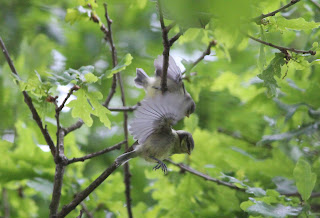Fantastic Fledglings!
I've counted lots of fledglings this summer, it feels like it has been a good year and the parent birds have done an amazing job, so here are some figures and photos (click on them to enlarge) to celebrate it.
Since we were already looking after birds nesting on the shore, we also kept an eye on the Ringed Plovers nesting close by and often within the tern colony site. The Eccles pairs did exceptionally well after a rocky start with predation an issue, but once the terns got hatching, the Ringed Plovers seemed to find safety in numbers with their second broods.
I think you would agree that both these shore nesting birds produce young with a very high 'cute factor'! I'll be back there next year trying to keep the predators at bay and disturbance from human and canine beach users to a minimum. Terns dislike dogs, and are sometimes not too fond of people either! I can particularly empathise with them when unsavoury characters decide to steal eggs and vandalise the site as happened in Kessingland and Crimdon near Hartlepool.
St Stephens Street, Norwich:
St Stephens Street in Norwich may seem a bizarre place to be counting fledglings but when I heard from the British Trust for Ornithology (BTO) that there was a gap in the data for the European Breeding Bird Atlas in this area of Norwich for evidence of breeding Herring Gulls, I felt it was a good place to look. Lesser Black Backed Gulls had definitely been nesting on the roof tops of the shops and office blocks so maybe in among them were some Herring Gulls. So when I was in the city I spent a few minutes checking out the gull fledglings, sure enough the LB's were there, but also, walking on the top of the low roof of Poundland was a Herring Gull youngster. I added the records to BirdTrack and BTO will incorporate those records to EBBA.
 |
| Blue Tit fledglings exploring the trees or chasing parents! |
Let's start in the garden:
I always do regular bird counts in the garden and this year I decided to keep a tally of fledglings, as best I could! See the table below for peak counts of each species & estimates of total fledglings.

As you can see Blackbirds were the real stars, working so hard with a peak count of eight. It wasn't all plain sailing, as a few had feather issues which hampered their progression, and they seemed particularly dependent on my garden for mealworms. One I named Rumpy as he lost so many feathers in that area, and there was another with a weird thing going on on its throat (see photo)! It was nice to see the early broods still visiting the garden as they turned 'black' later in the summer.
I'm pretty sure the Robins lost a parent on their second brood (lost the young from first brood early on sadly) but the remaining parent worked tirelessly to bring four through single-handed. With the Dunnock however, I struggled to keep up with their comings and goings, who was paired with who? In the end I think it was just the one female close by and since I didn't see so many fledglings, maybe that backs it up. Tits all turned up on the feeders with juveniles, it was fun to watch them learning how to use them several slipping underneath! Finches were not so frequent on the feeders but their regularity increased when they were feeding at the nest, like the Starlings I think they nested a little way away so the youngsters didn't appear until they were good fliers.
I always do regular bird counts in the garden and this year I decided to keep a tally of fledglings, as best I could! See the table below for peak counts of each species & estimates of total fledglings.

As you can see Blackbirds were the real stars, working so hard with a peak count of eight. It wasn't all plain sailing, as a few had feather issues which hampered their progression, and they seemed particularly dependent on my garden for mealworms. One I named Rumpy as he lost so many feathers in that area, and there was another with a weird thing going on on its throat (see photo)! It was nice to see the early broods still visiting the garden as they turned 'black' later in the summer.
I'm pretty sure the Robins lost a parent on their second brood (lost the young from first brood early on sadly) but the remaining parent worked tirelessly to bring four through single-handed. With the Dunnock however, I struggled to keep up with their comings and goings, who was paired with who? In the end I think it was just the one female close by and since I didn't see so many fledglings, maybe that backs it up. Tits all turned up on the feeders with juveniles, it was fun to watch them learning how to use them several slipping underneath! Finches were not so frequent on the feeders but their regularity increased when they were feeding at the nest, like the Starlings I think they nested a little way away so the youngsters didn't appear until they were good fliers.
 |
| One of the busy Blackbird Mums, they're mad for mealworms. |
 |
| What a state! No idea what was going on here, if it was just feathers or some flesh too. |
 |
| Oh hello, it's fledgling Rumpy! Looks better from this angle, & just checking out me and the cat. |
 |
| Young male on the moult from brown to black! |
 |
| Single parent needing a helping hand finding food for the young family. |
 |
| Posse of Starling adults in gathering mealworms to take back to the families. |
 |
| Tree-loving Starling! ;) |
Video taken with camera trap of the Starling fledglings at breakfast and a brief cameo from Rumpy at the end.
Little Tern Volunteer Wardening on the East Norfolk Coast:
This summer for the first time I helped RSPB look after the Little Tern colonies at Eccles and Winterton. Little Tern populations have declined (feels like a repetitive story with many seabirds sadly), so colonies in the UK have been given some special care over recent years to try to help their recovery.
There was intense activity at Eccles with the smaller site providing home to slightly more birds than the larger fenced off area at Winterton. The infographic below (by head warden Fabienne Fossez) provides a summary of the birds efforts (and ours) and it shows what a good year they had! It wasn't without challenge due to some seriously high tides washing out a few nests (fortunately early enough so they could try again), but the real culprit at Winterton was a rogue kestrel, who treated Little Tern fledglings as fast food! Despite this, a fantastic 260 young fledged across both sites, so close to topping 300! It just shows the fine margins that declining populations live by. Read more about the project and this year in detail here: https://www.littleterns.org/
There was intense activity at Eccles with the smaller site providing home to slightly more birds than the larger fenced off area at Winterton. The infographic below (by head warden Fabienne Fossez) provides a summary of the birds efforts (and ours) and it shows what a good year they had! It wasn't without challenge due to some seriously high tides washing out a few nests (fortunately early enough so they could try again), but the real culprit at Winterton was a rogue kestrel, who treated Little Tern fledglings as fast food! Despite this, a fantastic 260 young fledged across both sites, so close to topping 300! It just shows the fine margins that declining populations live by. Read more about the project and this year in detail here: https://www.littleterns.org/
 |
| Adult Little Tern looking for food in the shallows, they don't travel far for food so a good supply close by is vital. |
 |
| Courtship with a fish gift! |
 |
| Conflict during courtship. |
 |
| Dispute! |
 |
| Seeing off a gull was no problem! |
 |
| The rogue female Kestrel at Winterton in her bloomers! Not so easy to see off! |
 |
| This fish looks a bit big but somehow the chick gets it down. |
 |
| Two bundles of fluff not exactly hiding on the mound of sand, its a good thing they blend in. |
 |
| And then there were three! |
When the juveniles are ready to fly, the adults encourage them into the air by flying closely past them carrying a fish, and usually calling. Terns actually make quite a bit of noise most of the time! Once airborne the adults make them fly a few circuits of the colony to build up stamina (it wouldn't be long before they head to Africa after all) and then they drop down to the foreshore and feed them the reward. It's brilliant to watch!
 |
| Little Tern fledgling still with a few downy feathers but ready to exercise wings rather than legs, & beautifully camouflaged! |
Since we were already looking after birds nesting on the shore, we also kept an eye on the Ringed Plovers nesting close by and often within the tern colony site. The Eccles pairs did exceptionally well after a rocky start with predation an issue, but once the terns got hatching, the Ringed Plovers seemed to find safety in numbers with their second broods.
 |
| Typical Ringed Plover adult in action running across the sand. Yes they're tiny too! |
 |
| Adult with a Darter dragonfly snack. |
 |
| Fledgling already learned the running across the sand thing! |
 |
| Fledgling doing the stare! |
 |
| Hunkered down... there are two doing stone impressions avoiding predators! |
I think you would agree that both these shore nesting birds produce young with a very high 'cute factor'! I'll be back there next year trying to keep the predators at bay and disturbance from human and canine beach users to a minimum. Terns dislike dogs, and are sometimes not too fond of people either! I can particularly empathise with them when unsavoury characters decide to steal eggs and vandalise the site as happened in Kessingland and Crimdon near Hartlepool.
St Stephens Street, Norwich:
St Stephens Street in Norwich may seem a bizarre place to be counting fledglings but when I heard from the British Trust for Ornithology (BTO) that there was a gap in the data for the European Breeding Bird Atlas in this area of Norwich for evidence of breeding Herring Gulls, I felt it was a good place to look. Lesser Black Backed Gulls had definitely been nesting on the roof tops of the shops and office blocks so maybe in among them were some Herring Gulls. So when I was in the city I spent a few minutes checking out the gull fledglings, sure enough the LB's were there, but also, walking on the top of the low roof of Poundland was a Herring Gull youngster. I added the records to BirdTrack and BTO will incorporate those records to EBBA.
It certainly has been a good year for counting fledglings, and I can't wait to see what happens next year!




Comments
Post a Comment